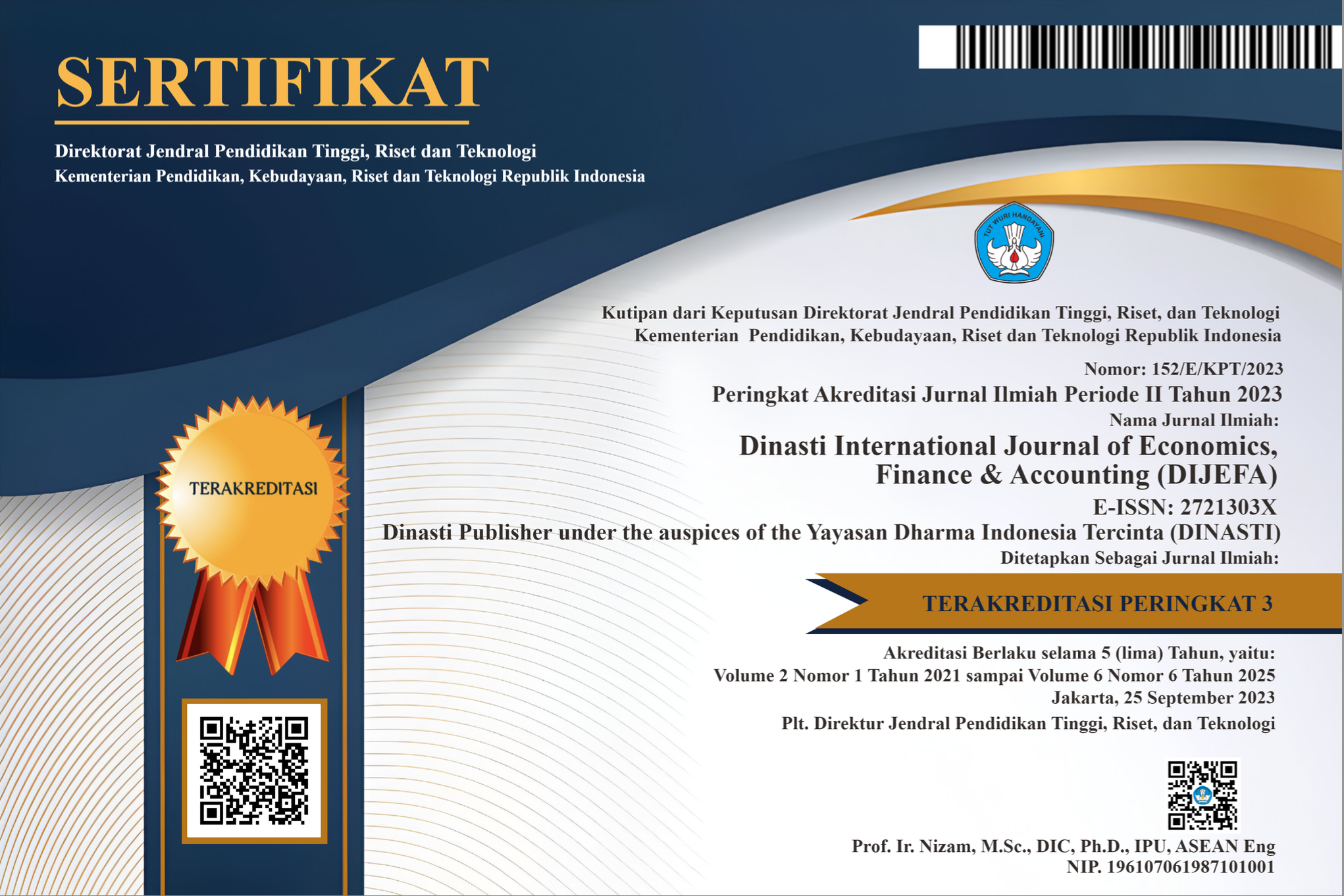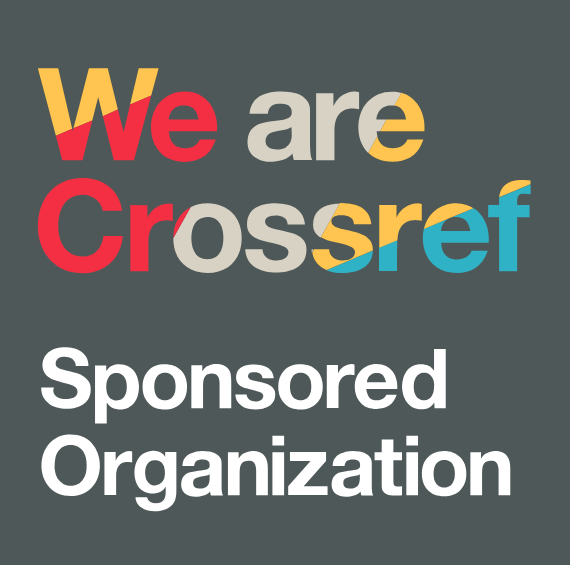FISCAL FACILITIES TO IMPROVE EXPORT PERFORMANCE
DOI:
https://doi.org/10.38035/dijefa.v1i1.228Keywords:
Performance Ekspor, Tax Incentif, Exports, Bonded Zone, ManufactureAbstract
The Indonesian government, issued a number of policies to help exporters to be able to compete in the world market by exempting import duties or returning import duties on imported goods for export purposes in the form of Bonded Zone and KITE.The policy is aimed at attracting foreign investment and increasing exchange rates, as a laboratory for economic reform and technology transfer, as well as increasing labor force in unproductive areas. Providing facilities provided by the government During 2017 to 1,606 companies valued at Rp 57.28 T from that year. In that year, the total value of exports produced was Rp. 780.8 T, or covering 47.23% of the total national manufacturing exports. The existence of KB and KITE facilities has stimulated the formation of gross fixed capital of IDR 178.17 trillion throughout 2017. From the spillover effect, companies receiving facilities in KB and KITE involve as many as 95,251 business networks, including 68,234 in KB that absorb labor 1.13 million people work and 27,017 business networks in KITE with a workforce of 292.2 thousand people. The presence of companies in KB and KITE contributed to the creation of indirect economic activity of 268,508 businesses, the majority of companies that obtain KB and KITE facilities come from the Western Region of Indonesia, where the number of recipients is concentrated in Java with the largest percentage of companies receiving facilities of 90.35 percent. While, West Java is the province with the largest percentage of KB and KITE facility recipients, which is around 43.90 percent. These results are in accordance with current conditions, where West Java Province is a province that has the most industrial estates in Indonesia, namely 25 industrial estates or equivalent to 33.8 percent of the total 74 industrial estates in Indonesia.
References
Ainin, S., Kamarulzaman, Y., Farinda, A. G., & Azmi, A. C. (2010). Business and Entrepreneur Characteristics influence on Business Performance of Professional Small Medium Enterprises. European Conference on Innovation and Entrepreneurship.
Ansoff, H. I. (1980). Strategic issue management. Strategic Management Journal. https://doi.org/10.1002/smj.4250010204
Ariel Sarache Castro, W., Cespón Castro, R., Ibarra Mirón, S., & Alonso Martínez, P. U. (2004). Modular manufacturing: An alternative to improve the competitiveness in the clothing industry. International Journal of Clothing Science and Technology. https://doi.org/10.1108/09556220410527228
Ark, B. Van, Dollar, D., & Wolff, E. N. (2006). Competitiveness, Convergence and International Specialization. The Economic Journal. https://doi.org/10.2307/2235470
Best, R. (2009). Market-based management (5th ed.). Upper Saddle River NJ: Prentice Hall.
Bhavani, T. A. (2002). Discussion Paper No . 2002 / 76 Impact of Technology on the Competitiveness of the Indian Small Manufacturing Sector A Case Study of the Automotive Component Industry, 10–11.
Bilalis, N., Wassenhove, L. N. Van, Maravelakis, E., & Enders, A. (2006). Insights from research An analysis of European textile sector competitiveness. Leonardo. https://doi.org/10.1108/13683040610652195
Bowman, C., & Ambrosini, V. (2000). Value Creation Versus Value Capture: Towards a Coherent Definition of Value in Strategy. British Journal of Management. https://doi.org/10.1111/1467-8551.00147
Casadesus-Masanell, R., & Ricart, J. E. (2010). Competitiveness: Business model reconfiguration for innovation and internationalization. Management Research. https://doi.org/10.1108/1536-541011066470
Cravens D. & Piercy N. (2012). Strategic Customer Management: Systems, Ethics, and Social Responsibility. Strategic Marketing.
Cravens, D. W., Piercy, N. F., & Baldauf, A. (2009). Management framework guiding strategic thinking in rapidly changing markets. Journal of Marketing Management. https://doi.org/10.1362/026725709x410025
Das, P. (2016). Export Competitiveness and Intensity of Technology in Indian Manufacturing Industries – Analysis with ASI Unit Level Data, (September).
Ferdinand, A. T., & Prof. Barry Richie, P. (1999). Strategic Pathways Toward Sustainable Competitive Advantage. Graduate College of Management.
Hallward-Driemeier, M., Wallsten, S., & Xu, L. C. (2006). Ownership, investment climate and firm performance. The Economics of Transition. https://doi.org/10.1111/j.1468-0351.2006.00267.x
Hill, T., & Westbrook, R. (1997). SWOT Analysis: It’s Time for a Product Recall. Long Range Planning. https://doi.org/10.1016/S0024-6301(96)00095-7
Hitt, M. A., Ireland, R. D., & Hoskisson, R. (2012). Strategic Management Cases: Competitiveness and Globalization. Cengage Learning Academic Resource Center. https://doi.org/10.1017/CBO9781107415324.004
Junior, L. B., Aguiar, J. F., Basso, L. C., & Kimura, H. (2012). Intangible Assets and Value Creation at Brazilian Companies: An Application for the Brazilian Textile Manufacturing Sector. SSRN Electronic Journal. https://doi.org/10.2139/ssrn.1567570
Karabag, S. F., Lau, M. C. K., & Suvankulov, F. (2014). Determinants of firm competitiveness: case of the Turkish textile and apparel industry. Journal of the Textile Institute. https://doi.org/10.1080/00405000.2013.811787
Khan, S., Murtaza, G., Jamil, R. A., & Qadir, I. (2017). Confirmatory Analysis of the Factors of Competitiveness in the Textile Industry of Pakistan. Sarhad Journal of Management Sciences. https://doi.org/10.31529/sjms.2017.3.1.6
Kohli, A. K., & Jaworski, B. J. (2012). Market Orientation: The Construct, Research Propositions, and Managerial Implications. In Developing a Market Orientation. https://doi.org/10.4135/9781452231426.n2
Kotler, P., & Keller, K. L. (2009). Marketing management (13th ed.). In Prentice Hall.
Kotler, Philip, & Armstrong, G. (2013). Principles of Marketing 15. World Wide Web Internet And Web Information Systems. https://doi.org/10.2307/1250103
Lau, C. K., To, K. M., Zhang, Z., & Chen, J. (2009). Determinants of competitiveness: Observations in China’s textile and apparel industries. China and World Economy. https://doi.org/10.1111/j.1749-124X.2009.01141.x
Lau, M. C. K. (2010). Institute of Textiles and Clothing Essays in Unit Root Test and Competitiveness?: Evidence from China and her Textiles Industry.
Lindman, M., Pennanen, K., Rothenstein, J., Scozzi, B., & Vincze, Z. (2016). The value space: how firms facilitate value creation. Business Process Management Journal. https://doi.org/10.1108/BPMJ-09-2015-0126
Maravelakis, E., Bilalis, N., Antoniadis, A., Jones, K. A., & Moustakis, V. (2006). Measuring and benchmarking the innovativeness of SMEs: A three-dimensional fuzzy logic approach. Production Planning and Control. https://doi.org/10.1080/09537280500285532
Mesquita, L. F., Lazzarini, S. G., & Cronin, P. (2007). Determinants of firm competitiveness in Latin American emerging economies: Evidence from Brazil’s auto-parts industry. International Journal of Operations and Production Management. https://doi.org/10.1108/01443570710742384
Mintzberg, H., & Quinn, J. B. (2003). THE STRATEGY PROCESS (4TH EDITION) (Book). Mt Eliza Business Review.
Mok Kim Man, S. A. W. (2008). Distinctive Capabilities and The Performance of Small and Medium-Size Enterprises (Smes) in Malaysia , Universiti Malaysia Sabah. International Business & Economics Research Journal – June 2008.
Ngo, L. V., & O’Cass, A. (2009). Creating value offerings via operant resource-based capabilities. Industrial Marketing Management. https://doi.org/10.1016/j.indmarman.2007.11.002
Othman, R., & Sheehan, N. T. (2011). Value creation logics and resource management: a review. Journal of Strategy and Management. https://doi.org/10.1108/17554251111110096
Porter, M. E. (1990). New global strategies for competitive advantage. Planning Review. https://doi.org/10.1108/eb054287
Prahalad, C. K., & Ramaswamy, V. (2004). Co-creation experiences: The next practice in value creation. Journal of Interactive Marketing. https://doi.org/10.1002/dir.20015
Priem, R. L. (2007). A consumer perspective on value creation. Academy of Management Review. https://doi.org/10.5465/AMR.2007.23464055
Robinson, R. B., & Pearce, J. A. (2011). Research Thrusts in Small Firm Strategic Planning. Academy of Management Review. https://doi.org/10.5465/amr.1984.4278109
Sánchez-Gutiérrez, J., Cabanelas, P., Lampón, J. F., & González-Alvarado, T. E. (2019). The impact on competitiveness of customer value creation through relationship capabilities and marketing innovation. Journal of Business and Industrial Marketing. https://doi.org/10.1108/JBIM-03-2017-0081
Schroeder, D. M., Congden, S. W., & Gopinath, C. (1995). LINKING COMPETITIVE STRATEGY AND MANUFACTURING PROCESS TECHNOLOGY. Journal of Management Studies. https://doi.org/10.1111/j.1467-6486.1995.tb00339.x
Siggel, E. (2006). International competitiveness and comparative advantage: A survey and a proposal for measurement. Journal of Industry, Competition and Trade. https://doi.org/10.1007/s10842-006-8430-x
Stabell, C. B., & Fjeldstad, Ø. D. (1998). Configuring value for competitive advantage: on chains, shops, and networks. Strategic Management Journal. https://doi.org/10.1002/(sici)1097-0266(199805)19:5<413::aid-smj946>3.3.co;2-3
Sutton, F. X., & Selznick, P. (2006). Leadership in Administration: A Sociological Interpretation. American Sociological Review. https://doi.org/10.2307/2088633
Veselinova, E., & Gogova-Samonikov, M. (2012). SMEs Inovation and Growth in EU. Management - Journal for Theory and Practice of Management. https://doi.org/10.7595/management.fon.2012.0022
Wheelen, T. L., & David Hunger, J. (2012). Strategic Management and Business Policy Toward Global Sustainability Thirteenth Edition. Strategic Management and Business Policy Toward Global Sustainability.
Wong, S. K. S., & Tong, C. (2012). The influence of market orientation on new product success. European Journal of Innovation Management. https://doi.org/10.1108/14601061211192852
Wooldridge, B., & Floyd, S. W. (1990). The strategy process, middle management involvement, and organizational performance. Strategic Management Journal. https://doi.org/10.1002/smj.4250110305
Zadek, S. (2006). Responsible competitiveness: Reshaping global markets through responsible business practices. Corporate Governance: The International Journal of Business in Society. https://doi.org/10.1108/14720700610689469
Downloads
Published
How to Cite
Issue
Section
License
Authors who publish their manuscripts in this journal agree to the following conditions:
- The copyright on each article belongs to the author(s).
- The author acknowledges that the Dinasti International Journal of Economics, Finance & Accounting (DIJEFA) has the right to be the first to publish with a Creative Commons Attribution 4.0 International license (Attribution 4.0 International (CC BY 4.0).
- Authors can submit articles separately, arrange for the non-exclusive distribution of manuscripts that have been published in this journal into other versions (e.g., sent to the author's institutional repository, publication into books, etc.), by acknowledging that the manuscript has been published for the first time in the Dinasti International Journal of Economics, Finance & Accounting (DIJEFA).


























































